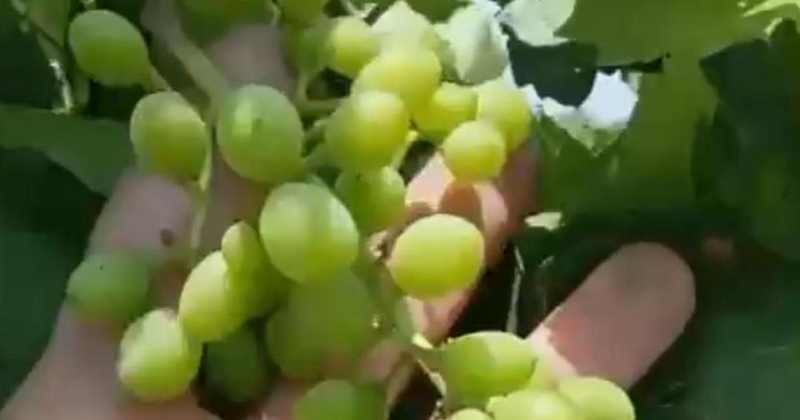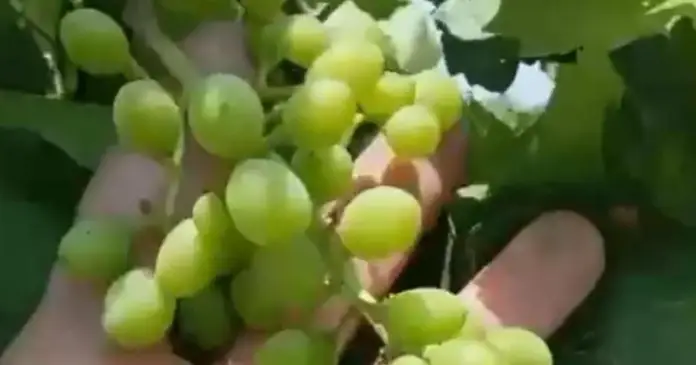In Tamaulipas, alternative crops continue to evolve, and although slowly and on smaller scale, they have already marked a turning point in several regions of the state where only grains and vegetables were previously produced.
Such is the case of the experimental grape field in the municipality of Jaumave, which consists of 4 hectares located in the Matías García ejido (common land). Eight varieties of this fruit of European origin are being developed there and will be used for winemaking, as well as for table consumption.
Historian Alberto Rodríguez Sánchez detailed for Expreso the documentation of this space dedicated to grapes, one of the few existing in Tamaulipas. In the Matías García vineyard, up to eight grape varieties are being produced, four of which are destined to be made into wine and the other four for consumption as fruit.
“In the “Matías García” ejido orchard in Jaumave, Tamaulipas, the Muscat of Alexandria, Merlot, Attica, Cabernet Sauvignon, French Cabernet, Superior, and Sultamine stand out.”
“The Sultamine was planted as a graft on July 3, 2023. The graft is irrigated via drip irrigation,” Alberto Rodríguez reported on his “Haciendas de Tamaulipas” history page. He also highlights that “this orchard has 3/4 hectares of Sultamine grapes, a prototype to learn about their adaptation to the area in the coming seasons.”
BETWEEN NOPALES AND GRAPES
Although Tamaulipas is not among the main grape producers in Mexico, the state has begun to develop initiatives to promote this crop, especially in the highland region, which includes municipalities such as Jaumave, Tula, Palmillas, and Miquihuana. Matías García’s project seeks to evaluate this variety’s adaptation to the region’s semi-arid climate, with the intention of expanding its production in the future.
Additionally, the Monterredondo Vineyard, considered the state’s only tourist vineyard, is located in the municipality of Tula. Covering approximately one and a half hectares, this vineyard cultivates varieties such as Tempranillo, Merlot, and Lambrusco. It opened its doors to the public in 2021, offering tours and tastings, which has contributed to diversifying the region’s tourism offerings. These initiatives are part of a broader effort to diversify agricultural production in the Tamaulipas highlands, an area that has historically faced limitations due to its climate and geography. Although current production is limited, these projects could lay the foundation for more robust winemaking development in the future.
National table grape production registered a 6.19% increase in 2022, reaching 380,998 tons. Sonora leads the production with 80.6% of the total, followed by Zacatecas and Aguascalientes.
Tamaulipas does not yet contribute significantly to these figures; however, the climatic conditions of the highlands could offer a favorable environment for grape cultivation if appropriate techniques are implemented and research and development continue in the region. The boost to grape cultivation in Tamaulipas not only represents an opportunity to diversify the state’s agricultural economy but also to position itself in the growing wine tourism market, which has gained popularity in various regions of the country.
OTHER ALTERNATIVE CROPS
As a result of climate change and the fluctuations in international markets, Tamaulipas producers have been seeking alternative crops for more than a decade.
Striking examples include sunflower production, which has been promoted for more than five years in municipalities such as González and Camargo. Specialists assert that sunflower production helps prevent soil desertification and has a regulating effect on pests, weeds, and diseases, and also increases soil organic matter. Furthermore, because it is a short-cycle crop, it requires less water than corn and sorghum. In municipalities such as Güémez, Padilla, Llera, and Victoria, Hass avocado cultivation is beginning to gain ground, with a current area of around 200 hectares and a steady and accelerated growth.
Meanwhile, in Altamira, soybeans have established themselves as a strategic crop, positioning the municipality as the largest producer nationwide. Throughout Tamaulipas, 40,000 hectares are currently planted, primarily in the southern region, with significant expansion potential thanks to favorable soil and climate conditions in much of the state.
This outlook opens up opportunities to integrate producers with the processing industry and agricultural organizations. Soybeans offer potential for development both under rainfed and irrigated conditions, not only in Altamira but also in the north of the state.
Its marketing is assured thanks to the demand from companies dedicated to the production of oil and nutritional products. In the central highlands of Tamaulipas, municipalities such as Jaumave and Palmillas have been investing in the cultivation of aloe vera, a native plant with extensive medicinal and cosmetic properties, for the past three years. Currently, 500 hectares of aloe vera are cultivated in both municipalities, with the goal of reaching 2,000 hectares in the coming years, driven by high demand from the international market.

Source: expreso.pres




